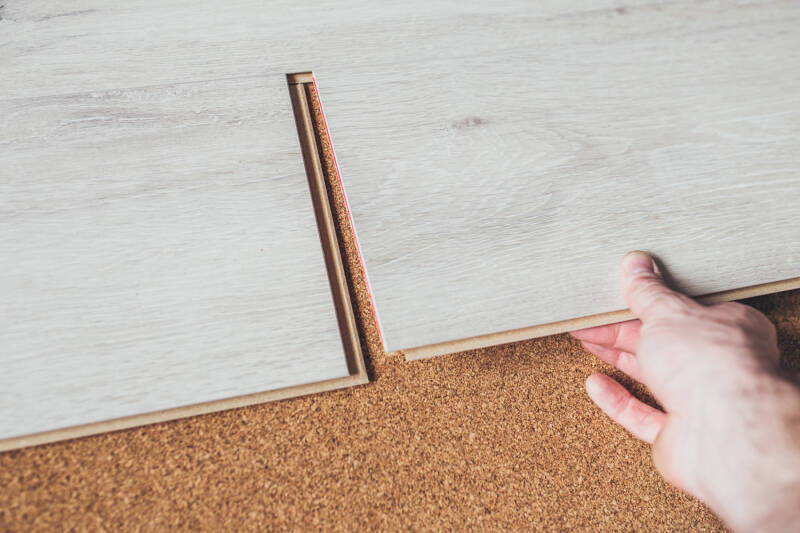Cork underlayment is an excellent choice for many types of floors, both wooden and brick. Here are a few reasons why you should consider using a cork underlay:
Sound insulation: cork flooring effectively dampens the sounds of knocks and footsteps, which can be especially important in multi-family apartments or houses with thin walls.
Thermal insulation: cork acts as a natural insulator, helping to maintain an optimal room temperature, which can help save energy.
Flexibility and durability: cork is a flexible material, which allows it to adapt to uneven surfaces. It is also resistant to deformation and damage.
Environmental friendliness: cork is a renewable material, which makes it environmentally friendly.
Easy to install: Cork flooring is usually easy to install and can be cut to size.
For wood floors, a cork underlay also helps distribute weight evenly and can improve the durability of the floor. However, in the case of brick floors, a cork underlay improves walking comfort and can help smooth out any unevenness.
If you plan to install a cork subfloor, make sure the floor surface is well prepared and clean. It is also important to check the manufacturer's requirements for the thickness and type of substrate to ensure optimal conditions for your floor.

Cork underlayment can be used in a variety of situations, and the decision to use an adhesive depends on several factors. Here are some situations where you might want to consider using an adhesive when installing your cork underlayment:
Floors in high-traffic areas: If you’re installing cork underlayment in areas that see a lot of wear and tear, such as hallways, offices, or stores, an adhesive can provide additional stability and durability by preventing the underlayment from shifting.
Floors on uneven surfaces: If the subfloor you’re installing your cork underlayment on is uneven or has some imperfections, using an adhesive can help the underlayment adhere better and even out the surface.
Floors in high-humidity rooms: In areas with high humidity (e.g. kitchens, bathrooms), an adhesive can help seal the cork underlayment from moisture, which can increase the durability and effectiveness of the underlayment.
For acoustically insulating underlays: If the cork underlay has additional acoustic insulation properties and the manufacturer recommends using glue, it is worth following these tips to get the best soundproofing results.
Underfloor heating: For underfloor heating, glue can help stabilize the cork underlay and ensure even heat transfer.
How to use glue for cork underlay:
Choosing the glue: Use the glue recommended by the manufacturer of the cork underlay. This is usually a water-based glue or polyurethane glue that works well with cork.
Surface preparation: Make sure the subfloor is clean, dry and even. Clean it of dust, dirt and other contaminants.
Applying the glue: Apply the glue evenly to the floor surface using a roller or trowel, according to the glue manufacturer's recommendations. Make sure the glue is well spread.
Laying the underlay: After applying the glue, place the cork underlay on the surface, pressing lightly to ensure good adhesion. Use a floor roller to even out the underlayment and remove any air bubbles.
Drying time: Allow the adhesive to dry according to the manufacturer's instructions before proceeding with any further work, such as installing the actual flooring.
By using adhesive, you can ensure better durability and stability of the cork underlayment, which will contribute to a longer lifespan of the entire flooring system.

Cork and rubber cork underlays are two different materials that have their own specific properties and applications. Here are the key differences between them:
1. Composition and material:
Cork underlay:
Material: Made mainly of natural cork, which is a material derived from the bark of the cork oak. Cork is an ecological, renewable material and has shock-absorbing properties.
Properties: Cork underlay is known for its excellent acoustic and thermal insulation, as well as its elasticity and resistance to deformation.
Rubber cork underlay:
Material: It is a mixture of cork and rubber, which creates a more durable and resistant material. Rubber added to cork improves elasticity and abrasion resistance.
Properties: Rubber cork underlay combines the properties of cork with additional properties of rubber, making it more resistant to damage and loads.
2. Performance properties:
Cork underlay:
Acoustic insulation: Very good, dampens impact and footstep sounds.
Thermal insulation: Insulates heat well, which can help save energy.
Comfort: Provides good walking comfort, but may be less resistant to heavy loads.
Rubber cork underlayment:
Acoustic insulation: Also good, but can be even more effective at dampening sound with the addition of rubber.
Thermal insulation: Works similarly to cork underlayment, providing good thermal insulation.
Comfort: Better for heavy loads and heavy use, as the rubber adds abrasion resistance and durability.
3. Application:
Cork underlayment:
Where to use: Suitable for most domestic and commercial applications, including bedrooms, living rooms and offices. Can be used under wood, laminate and tile floors.
Limitations: May be less resistant to heavy loads, which may make it not the best choice for heavy use.
Rubber cork underlay:
Where to use: Due to its durability and resistance, it is ideal for high-traffic areas such as hallways, offices, shops and other high-use areas. It can also be used in conjunction with underfloor heating systems.
Limitations: It can be more expensive than traditional cork underlay, but it offers better durability.
4. Ecology and cost:
Cork underlay: Usually more eco-friendly because it uses natural, renewable materials. It can also be slightly cheaper than rubber cork.
Rubber cork underlay: Although also eco-friendly, it can be more expensive due to the addition of rubber and additional durability properties. However, due to its greater durability, it can offer better value for money in the long term.

